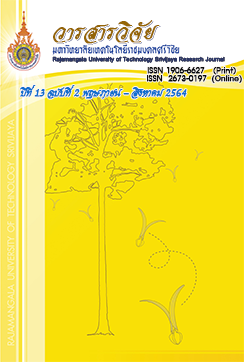Model Analysis of Air Pollution in Bangkok by Grey’s Theory
Keywords:
Grey theory, Suspended particulate matter, Natural of travel’s province.Abstract
ในการศึกษาครั้งนี้ การใช้แบบจำลอง Grey Model (GM) เพื่อพยากรณ์ปริมาณฝุ่นละอองขนาดเล็กกว่า 10 ไมครอน ค่าเฉลี่ย 24 ชั่วโมง (SPM10) โนกรุงเทพมหานครที่เป็นจังหวัดท่องเที่ยวท่องเที่ยวของประเทศไทย ตั้งแต่ พ.ศ. 2561-2565 รวม 6 ปีและค่าฝุ่นละออง SPM10 รอบ 5, 10, และ 20 ปี ข้างหน้าซึ่งตรงกับ พ.ศ. 2570, 2575 และ 2580 ตามลำดับ พบว่าค่าปริมาณฝุ่นละออง SPM10 พยากรณ์จะมีแนวโน้ม 2 แบบ คือ 1. สถานีที่มีแนวโน้มเพิ่มขึ้น ได้แก่ ไปรษณีย์ราษฎร์บูรณะ, กรมอุตุนิยมวิทยาบางนา, สำนักงานการเคหะชุมชนคลองจั่น, สนามกีฬาการเคหะชุมชนห้วยขวาง, โรงเรียนนนทรีวิทยา, โรงพยาบาลจุฬาลงกรณ์, ตรวจวัดกรมประชาสัมพันธ์และโรงเรียนบดินทรเดชา (สิงห์ สิงหเสนี) 2. สถานีที่มีแนวโน้มลดลง ได้แก่ มหาวิทยาลัยราชภัฎบ้านสมเด็จเจ้าพระยา, กระทรวงวิทยาศาสตร์และเทคโนโลยี, กรมขนส่งทางบก, สถานีการไฟฟ้าย่อยธนบุรี, ตำรวจนครบาลโชคชัยและตรวจวัดการเคหะชุมชนดินแดง ทั้งนี้จากค่าพยากรณ์ปริมาณฝุ่นละออง SPM10 ในอนาคตแสดงถึงการบริหารการจัดการที่ดี ลดปริมาณฝุ่นละออง ก็จะสามารถพัฒนาสนับสนุนการท่องเที่ยวแบบยั่งยืน เสริมสร้างภาพลักษณ์ที่ดีของประเทศได้
References
Deng, J. 1989. Introduction to Grey System Theory. The Journal of Grey System 1(1): 1-24.
Dend, J. 2005. Grey modeling resource theory and GM(1,1,bk). The Journal of Grey System 17(3): 201-206.
Diyar, A. and Mehmet, A. 2007. Grey prediction with rolling mechanism for electricity demand forecasting of Turkey. Energy 32(9): 1670-1675.
Erdal, K., Ulutas, B. and Kaynak, O. 2010. Grey System theory-based models in time series prediction. Expert Systems with Applications 37(1): 1784-1789.
Phonviboon, T., Thikaichaisawat, I. and Rungpisuthipong, A. 2014. Disaster in the Winter of Particle Matter (PM2.5). EAU Heritage Journal Science and Technology 8(1): 40-46. (in Thai)
Pollution Control Department Bangkok. 2017. Air and Noise Quality Division. Ministry of Natural Resources and Environment. Available Source: http://air4thai.pcd.go.th/webV2/history/, January, 20, 2017. (in Thai)
Rodthanee, A. 2015. Quantities of PM2.5 inside public vehicles in Bangkok. Thesis in Environmental Science, Silpakorn University. (in Thai)
Wongphan, V. 2018. Research Report no Study the Origin and Guidelines for the Management of Bong Dust, not more than 2.5 Microns in Bangkok and Suburb Areas. Pollution Control Department, Ministry of Natural Resources and Environment, Bangkok. Available Source: http://www.pcd.go.th, August 1, 2018. (in Thai)
Yang, X. and Wen, Y.H. 1997. The application of Grey Model on the forecast of passenger of international air transportation. Transport Planning Journal 26(3): 522-555.
Downloads
Published
How to Cite
Issue
Section
License
The content and information in the article published in Journal of Rajamangala University of Technology Srivijaya It is the opinion and responsibility of the author of the article. The editorial journals do not need to agree. Or share any responsibility.







